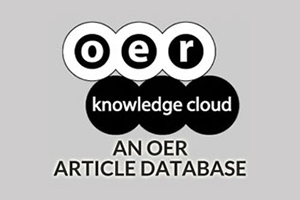An Analysis of Digital Education in Canada in 2017-2019
DOI:
https://doi.org/10.19173/irrodl.v22i2.5108Keywords:
digital education, higher education, university, college, Canada, qualitative analysisAbstract
Digital education refers to in-person, blended, and fully online learning efforts, as well as attempts to capture a wide range of teaching and learning contexts which make use of digital technology. While digital education is pervasive in Canada, pan-Canadian data on digital education are relatively scarce. The Canadian Digital Learning Research Association/Association Canadienne de Recherche sur la Formation en Ligne conducted pan-Canadian surveys of higher education institutions (2017-2019), collecting data on the digital education landscape and publishing annual reports of its results. Previous analyses of the data have used quantitative approaches. However, the surveys also collected responses to open-ended questions. In this study, we report a systematic analysis of qualitative data exploring the digital education landscape in Canada and its changes over time. Findings shed light on the growth of digital education, the situated and multidimensional nature of digital education, the adoption of openness, quality, and rigour, and the development of alternative credentials.
References
Agbra, L. (2018, February 10). Online university programs in Canada: New options for students. Maclean’s. https://www.macleans.ca/education/digital-classroom/
Bates, T., Desbiens, B., Donovan, T., Martel, E., Mayer, D., Paul, R., Poulin, R., & Seaman, J. (2017). Tracking online and distance education in Canadian universities and colleges: 2017. Canadian national survey of online and distance education in Canadian post secondary education. Canadian Digital Learning Research Association. https://onlinelearningsurveycanada.ca/publications-2017/
Bates, T. (2018). The 2017 national survey of online learning in Canadian post-secondary education: Methodology and results. International Journal of Educational Technology in Higher Education, 15, Article number: 29. https://doi.org/10.1186/s41239-018-0112-3
Blumer, H. (1969). Symbolic interactionism: Perspective and method. Prentice-Hall.
Bogdan, R. C., & Biklen, S. K. (2007). Qualitative research for education: An introduction to theory and methods (5th ed.). Allyn & Bacon.
Charmaz, K. (2006). Constructing grounded theory: A practical guide through qualitative analysis. Sage Publications.
Cronin, C., & MacLaren, I. (2018). Conceptualising OEP: A review of theoretical and empirical literature in Open Educational Practices. Open Praxis, 10(2), 127–143. https://doi.org/10.5944/openpraxis.10.2.825
Czerniewicz, L. (2018, October 29). Unbundling and rebundling higher education in an age of inequality. EDUCAUSE Review. https://er.educause.edu/articles/2018/10/unbundling-and-rebundling-higher-education-in-an-age-of-inequality
Donovan, T., Bates, T., Seaman, J., Mayer, D., Martel, E., Paul, R., Desbiens, B., Forssman, V., & Poulin, R. (2018). Tracking online and distance education in Canadian universities and colleges: 2018. Canadian national survey of online and distance education in Canadian post secondary education. Canadian Digital Learning Research Association. https://onlinelearningsurveycanada.ca/publications-2018/
Freeman, M., deMarrais, K., Preissle, J., Roulston, K., & St. Pierre, E. A. (2007). Standards of evidence in qualitative research: An incitement to discourse. Educational Researcher, 36(1) 25–32. https://doi.org/10.3102/0013189X06298009
Glaser, B. G., & Strauss. A. (1967). The discovery of grounded theory: Strategies for qualitative research. Aldine Publishing.
Hegarty, B. (2015). Attributes of open pedagogy: A model for using open educational resources. Educational Technology, (July–August), 3–13. https://upload.wikimedia.org/wikipedia/commons/c/ca/Ed_Tech_Hegarty_2015_article_attributes_of_open_pedagogy.pdf
Johnson, N. (2019). Tracking online education in Canadian universities and colleges: National survey of online and digital learning (2019 National Report). Canadian Digital Learning Research Association. https://onlinelearningsurveycanada.ca/publications-2019/
McGreal, R., & Anderson, T. (2007). E-learning in Canada. International Journal of Distance Education Technologies, 5(1), 1–6. https://auspace.athabascau.ca/bitstream/handle/2149/744/e-learning_in_canada.pdf?sequence=1&isAllowed=y
Merriam, S. (1995). What can you tell from an N of 1?: Issues of validity and reliability in qualitative research. PAACE Journal of Lifelong Learning, 4, 51–60. https://eric.ed.gov/?id=EJ497233
Mohr, S. C., & Shelton, K. (2017). Best practices framework for online faculty professional development: A Delphi study. Online Learning Journal, 21(4). http://dx.doi.org/10.24059/olj.v21i4.1273
Patton, M. Q. (2015). Qualitative research and evaluation methods (4th ed.). Sage.
Seaman, J. E., Allen, I. E., & Seaman, J. (2018). Grade increase: Tracking distance education in the United States. Babson Survey Research Group. https://onlinelearningsurvey.com/reports/gradeincrease.pdf
Statistics Canada. (2020). Canadian postsecondary enrolments and graduates, 2017/2018. https://www150.statcan.gc.ca/n1/daily-quotidien/200219/dq200219b-eng.htm
VanLeeuwen, C. A., Veletsianos, G., Belikov, O., & Johnson, N. (2020). Institutional perspectives on faculty development for digital education in Canada. Canadian Journal of Learning and Technology, 46(2) 1–20. https://doi.org/10.21432/cjlt27944
Veletsianos, G. (2016). Defining characteristics of emerging technologies and emerging rractices. In G. Veletsianos (Ed.), Emergence and innovation in digital learning: Foundations and applications (pp. 3–16). Athabasca University Press.
Weller, M., de los Arcos, B., Farrow, R., Pitt, B., & McAndrew, P. (2015). The impact of OER on teaching and learning practice. Open Praxis, 7(4) 351–361. http://dx.doi.org/10.5944/openpraxis.7.4.227
Published
How to Cite
Issue
Section
License
This work is licensed under a Creative Commons Attribution 4.0 International License. The copyright for all content published in IRRODL remains with the authors.
This copyright agreement and usage license ensure that the article is distributed as widely as possible and can be included in any scientific or scholarly archive.
You are free to
- Share — copy and redistribute the material in any medium or format
- Adapt — remix, transform, and build upon the material for any purpose, even commercially.
The licensor cannot revoke these freedoms as long as you follow the license terms below:
- Attribution — You must give appropriate credit, provide a link to the license, and indicate if changes were made. You may do so in any reasonable manner, but not in any way that suggests the licensor endorses you or your use.
- No additional restrictions — You may not apply legal terms or technological measures that legally restrict others from doing anything the license permits.







